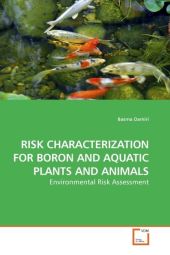 Neuerscheinungen 2010Stand: 2020-01-07 |
Schnellsuche
ISBN/Stichwort/Autor
|
Herderstraße 10
10625 Berlin
Tel.: 030 315 714 16
Fax 030 315 714 14
info@buchspektrum.de |

Basma Damiri
RISK CHARACTERIZATION FOR BORON AND AQUATIC PLANTS AND ANIMALS
Environmental Risk Assessment
2010. 108 S. 220 mm
Verlag/Jahr: VDM VERLAG DR. MÜLLER 2010
ISBN: 3-639-22207-5 (3639222075)
Neue ISBN: 978-3-639-22207-4 (9783639222074)
Preis und Lieferzeit: Bitte klicken
Boron enters aquatic environments from both natural and anthropogenic sources. Boron has been of recent interest due to elevated concentrations in waters from thermoelectric power generation, particularly flue gas desulfurization (FGD) waters. Its concentrations in FGD waters range from 33 to 460 mg B L-1. Typha latifolia and Schoenoplectus californicus are often used in constructed wetland treatment systems (CWTS) for FGD waters treatment. Boron in FGD waters may be phytotoxic to wetland plant species in CWTS. Accurate characterization of both phytotoxicity and toxicity of boron to aquatic vertebrates and invertebrates is important in order to predict risks in either CWTS or receiving aquatic systems. Based on the results from this research, CWTS for FGD waters should be planted with mature plants. If boron concentrations in aqueous exposures exceed 12.6 mg L-1 for either T. latifolia and S. californicus, survival of immature plants will be limited while mature plants can tolerate boron concentrations of 25 to 50 mg L-1. For the sensitive, sentinel aquatic animals, C. dubia and P. promelas, the NOEC for boron was 17.2 and 51.5 mg B L-1, respectively.
Basma Rafeeq H. Damiri is a PhD student at Clemson University. Her current research is in RNA interference, knockdown mice/ P450. She received her M.S. in Environmental Toxicology from Clemson University and B.S. in Medical Technology from Al-Quds University, Jerusalem.


